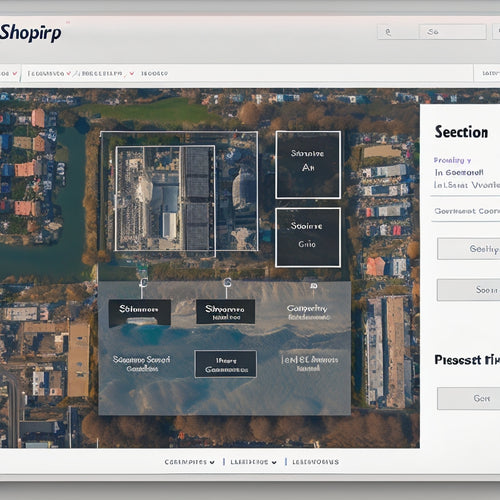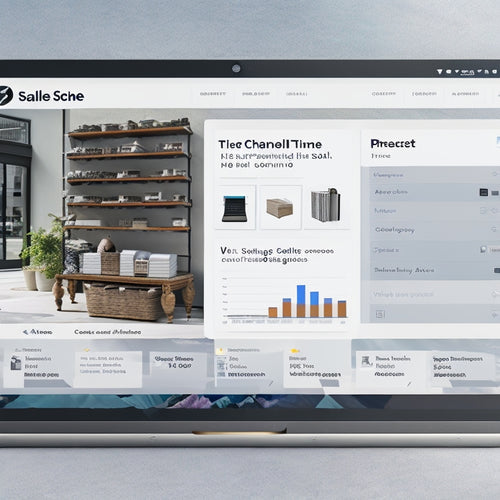
Create Online Courses Fast With Proven Strategies
Share
To create online courses fast with proven strategies, start by defining your target audience and identifying profitable course topics that fill a market gap. Then, plan engaging course content with clear learning objectives and interactive elements. Develop high-quality course assets, including visually appealing videos and images, and record and edit course videos that flow smoothly. Finally, set up an online course platform that aligns with your brand identity and promotes user engagement. By following these steps, you'll be well on your way to creating a successful online course. Now, let's dive deeper into the specifics of each step to secure your course's success.
Key Takeaways
• Define your target audience to create courses that cater to their needs, pain points, and goals, ensuring high engagement and sales.
• Choose profitable course topics by identifying market demands, gaps, and trends to create unique and in-demand offerings.
• Plan engaging course content with clear learning objectives, logical structures, and interactive elements to achieve learning outcomes.
• Create high-quality course assets, including visually appealing videos, images, and resources, to enhance the learning experience.
• Record and edit course videos with good lighting, sound, and editing to create seamless and engaging video content.
Define Your Target Audience
To create an online course that resonates with your students, you need to identify and understand your target audience, the people who'll be consuming and benefiting from your content. This is pivotal because it helps you tailor your course to their specific needs, increasing audience engagement and ultimately, their success.
So, who are they? What're their pain points, goals, and motivations? What problems do they face, and how can your course solve them?
To get into the minds of your target audience, you need to define your target demographics. Are they professionals, entrepreneurs, or hobbyists? What's their age range, occupation, and level of expertise? What're their interests, and what do they value most?
Choose Profitable Course Topics
Now that you've defined your target audience, it's time to choose a profitable course topic that resonates with them.
To do this, you'll need to:
- Identify popular demands
- Analyze market gaps
- Research profit trends
Identify Popular Demands
Your online course's success hinges on identifying profitable topics that resonate with a large audience, and the best place to start is by uncovering popular demands in the market. This is where market research comes in. By conducting thorough research, you'll be able to identify areas of high demand and create courses that cater to those needs.
Here are some popular topics across various industries:
| Industry | Popular Topics |
|---|---|
| Technology | Cloud computing, cybersecurity, artificial intelligence |
| Health and Wellness | Nutrition, yoga, mental health |
| Business | Entrepreneurship, marketing, finance |
As you can see, these topics are in high demand and have a large audience interested in learning more. By focusing on these areas, you can create online courses that resonate with a large audience and increase your chances of success. Remember, product development is key. Create high-quality courses that provide value to your students, and you'll be on your way to creating a profitable online course business.
Analyze Market Gaps
By scrutinizing the market, you'll uncover gaps where existing courses fall short, allowing you to create a unique offering that addresses those specific needs and sets your course apart from the competition.
Through market research, you'll identify areas where existing courses are lacking, and pinpoint opportunities to create something new and innovative.
To effectively analyze market gaps, you need to segment your audience. Identify specific demographics, interests, and pain points to create buyer personas. This will help you understand what your target audience is looking for and what they're not getting from existing courses.
Look for online communities, forums, and social media groups where your audience is active, and listen to their conversations. What're their biggest challenges? What're they struggling with? What do they wish they knew?
Research Profit Trends
You've likely identified some promising market gaps, and it's time to validate their profitability by researching trends that indicate a strong demand for specific course topics. This involves analyzing online platforms, social media, and industry reports to identify profitable trends.
Here's a breakdown of what to research:
| Trend Research | Tools | Goals |
|---|---|---|
| Social Media | Hashtag analytics, Facebook groups | Identify popular topics, engagement levels |
| Online Platforms | Udemy, Coursera, edX | Analyze course popularity, ratings, and reviews |
| Industry Reports | Google Trends, IBISWorld | Identify growth areas, industry insights |
| Competitor Analysis | Ahrefs, SEMrush | Analyze competitor pricing strategies, marketing tactics |
| Online Communities | Reddit, Quora | Identify pain points, popular discussions |
Plan Engaging Course Content
Now that you've chosen a profitable course topic, it's time to plan engaging content that resonates with your students.
You'll want to start by defining clear learning objectives that outline what students will achieve by the end of the course.
Next, you'll need to outline a logical course structure that breaks down complex topics into manageable, easy-to-follow modules.
Define Learning Objectives
To create an online course that truly resonates with your students, start by defining clear learning objectives that outline exactly what they'll be able to do or achieve by the end of your course. These objectives will serve as a roadmap, guiding your content creation and ensuring your students stay focused on what they need to accomplish.
When developing your learning objectives, make sure they're specific, measurable, achievable, relevant, and time-bound (SMART). This will help you create a clear direction for your course and enable your students to track their progress.
Outline Course Structure
With clear learning objectives in place, you can start building a course structure that's tailored to help students achieve those objectives, ensuring every piece of content serves a purpose.
Now, it's time to outline your course content in a way that improves engagement and increases retention. Start by breaking down your course into modules or lessons, each with its own specific objectives and outcomes. This will help you create a logical flow of content that's easy for students to follow.
Next, identify the key concepts, skills, or knowledge you want to cover in each module, and organize them in a way that builds upon previous lessons. Make sure to include interactive elements, such as quizzes, discussions, and assignments, to keep students engaged and motivated.
Create High-Quality Course Assets
You'll need a range of high-quality course assets, including videos, images, and downloadable resources, to engage and educate your students effectively. These assets will help you convey complex information in an easy-to-digest format, making your course more engaging and interactive.
To create visually appealing assets, you may need to develop your graphic design skills or outsource to a professional designer. Invest in a design tool like Canva or Adobe Creative Cloud to create stunning images, infographics, and illustrations that match your brand identity.
When it comes to video editing, you don't need to be a pro, but having some basic skills will help you trim, cut, and arrange your video clips to create a cohesive and engaging video. iMovie, Adobe Premiere, or DaVinci Resolve are user-friendly video editing tools that can help you get started.
Record and Edit Course Videos
Capturing high-quality video recordings is essential to conveying your message effectively, and it all starts with a solid understanding of your recording environment and equipment.
You'll want to make sure your video lighting is soft and even, free from harsh shadows or glare. Experiment with different camera angles to add visual interest and keep your viewers engaged.
When it comes to recording, invest in a good quality microphone to capture crisp, clear audio. Avoid using built-in laptop microphones, as they can pick up background noise and keyboard clatter.
Once you've recorded your video, it's time to edit. You'll want to trim, cut, and arrange your clips to create a seamless flow. Add smooth shifts to move smoothly between scenes, and use voiceover editing to refine your narration.
Don't be afraid to add text overlays, animations, or other visual effects to enhance your message. By following these tips, you'll be able to create polished, professional-looking videos that will captivate your audience and leave a lasting impression.
Set Up Online Course Platform
Now that you've polished your course videos, it's time to set up a platform to host and deliver them to your students. You'll want a platform that's easy to use, customizable, and scalable. Look for one that allows platform customization to match your brand's identity and style. This will help you establish a strong online presence and build trust with your students.
When selecting a platform, contemplate its marketing strategies and user engagement features. You want to be able to promote your course effectively and encourage student participation. Look for features like email marketing integrations, discussion forums, and quizzes to keep students engaged.
You'll also want to ponder course promotion features, such as course bundles, coupons, and affiliate marketing integrations. These will help you reach a wider audience and drive sales.
Frequently Asked Questions
How Do I Protect My Course Content From Being Stolen or Shared?
You'll want to safeguard your valuable content by registering for copyright protection, adding visible or invisible watermarking, and hosting on secure online course platforms with robust digital rights management and encrypted storage.
Can I Create a Course on a Topic I'm Not an Expert In?
"Fake it till you make it" isn't an option here; you can't create a credible course without expertise. You'll need to research extensively, establishing your credibility, or outsource to experts who can lend their authority to your content.
What if I'm Not Comfortable on Camera or Have Stage Fright?
You're not alone in fearing the camera or stage - many struggle with it! Overcoming fears and building confidence starts with small steps: practice public speaking strategies, focus on your message, and use presentation tips to engage your audience.
How Long Does It Typically Take to Create a High-Quality Online Course?
You'll typically spend 2-6 weeks designing your course, and 2-3 months creating high-quality content, with time management being key; after that, plan 1-2 months for the editing process, and you'll have a polished course in no time.
Can I Sell My Course on Multiple Platforms Simultaneously?
You can definitely sell your course on multiple platforms simultaneously, leveraging diverse marketing strategies to boost your online presence, thereby maximizing revenue potential and expanding your audience reach.
Related Posts
-

Adding Sitemap to Your Shopify Store: A Complete Guide
This article aims to provide a comprehensive guide on the process of adding a sitemap to a Shopify store. A sitemap ...
-

Efficiently Automate Your Shopify Store for Success
The automation of Shopify stores has become increasingly popular due to its potential benefits and the availability ...
-

What Can You Automate on Shopify
This article examines the potential for automation on the Shopify platform. It discusses the benefits of automation ...


